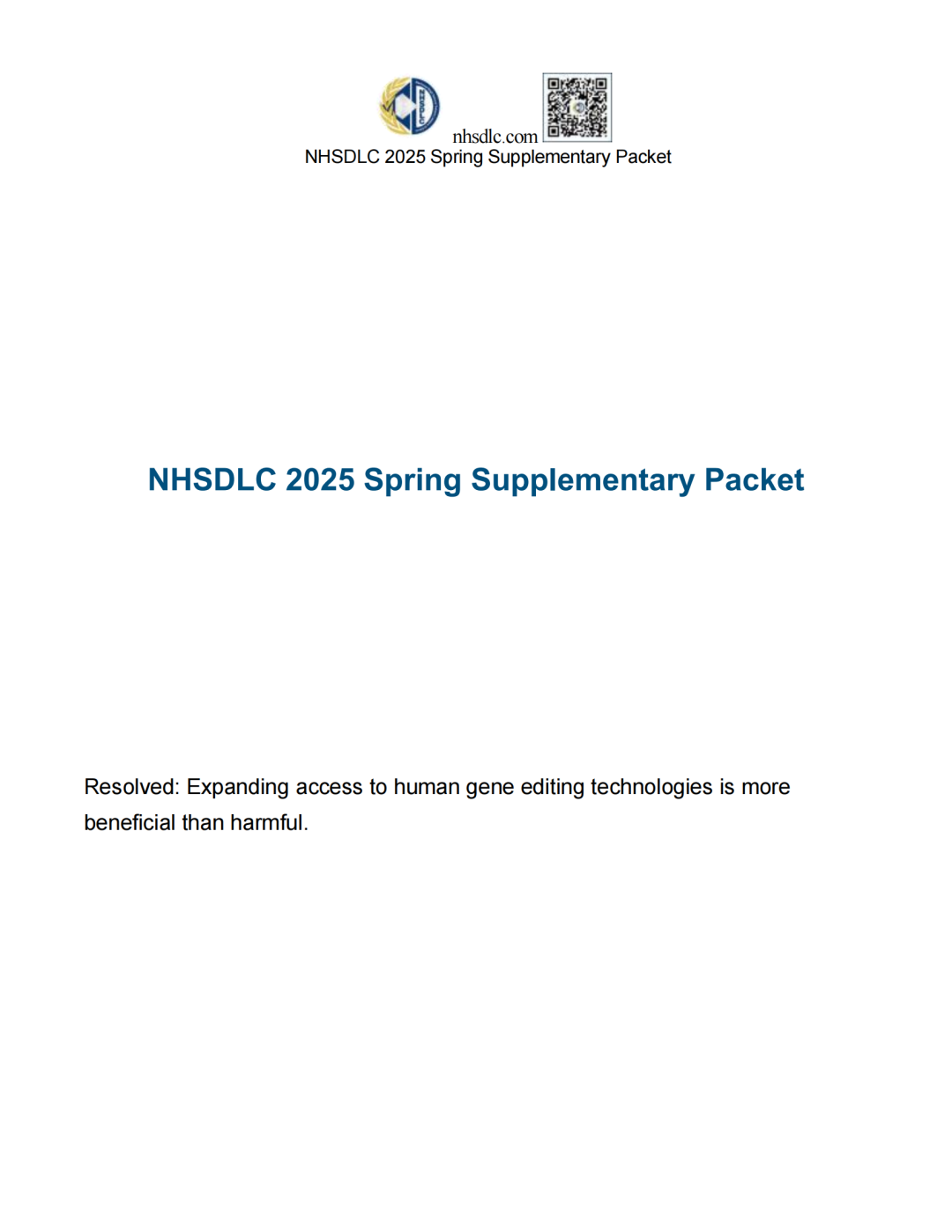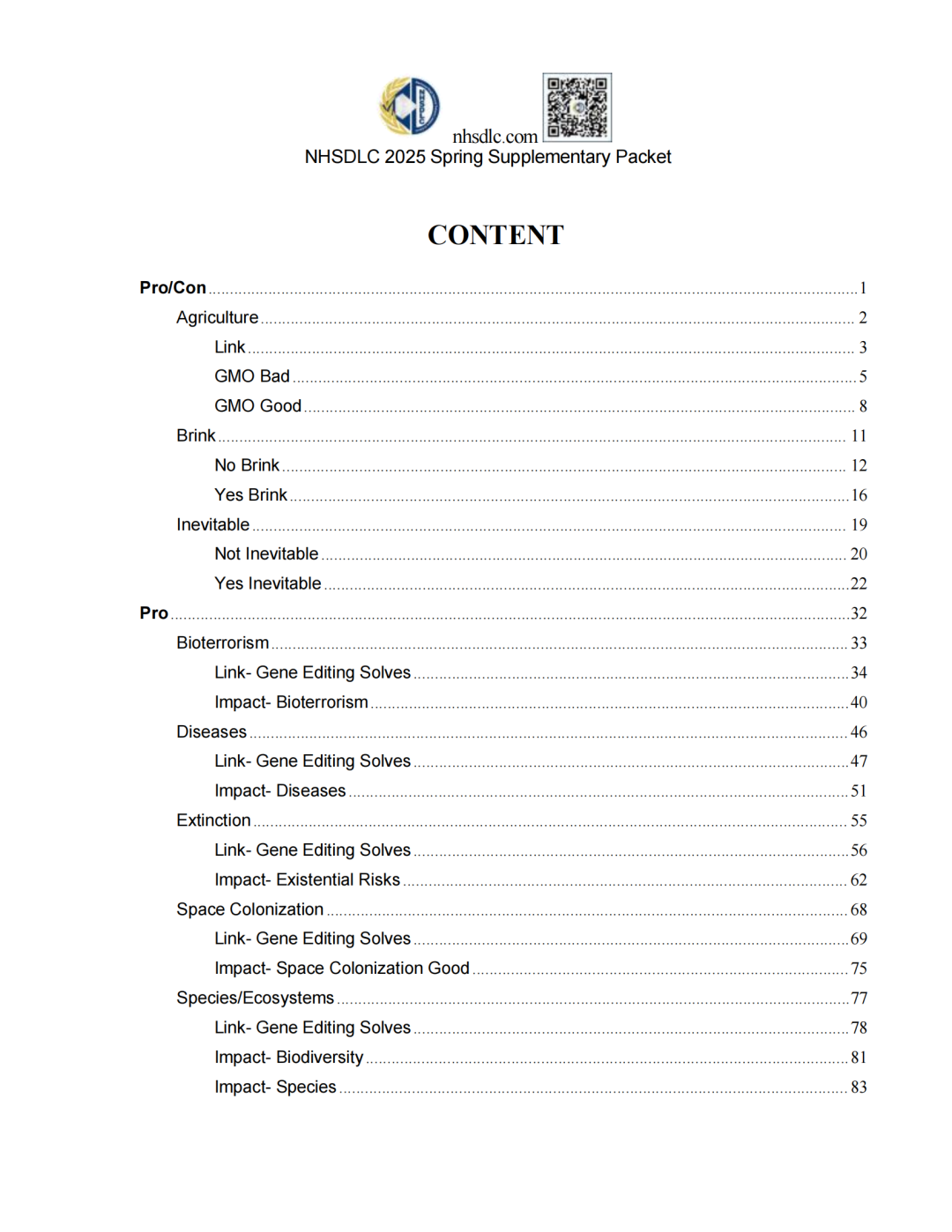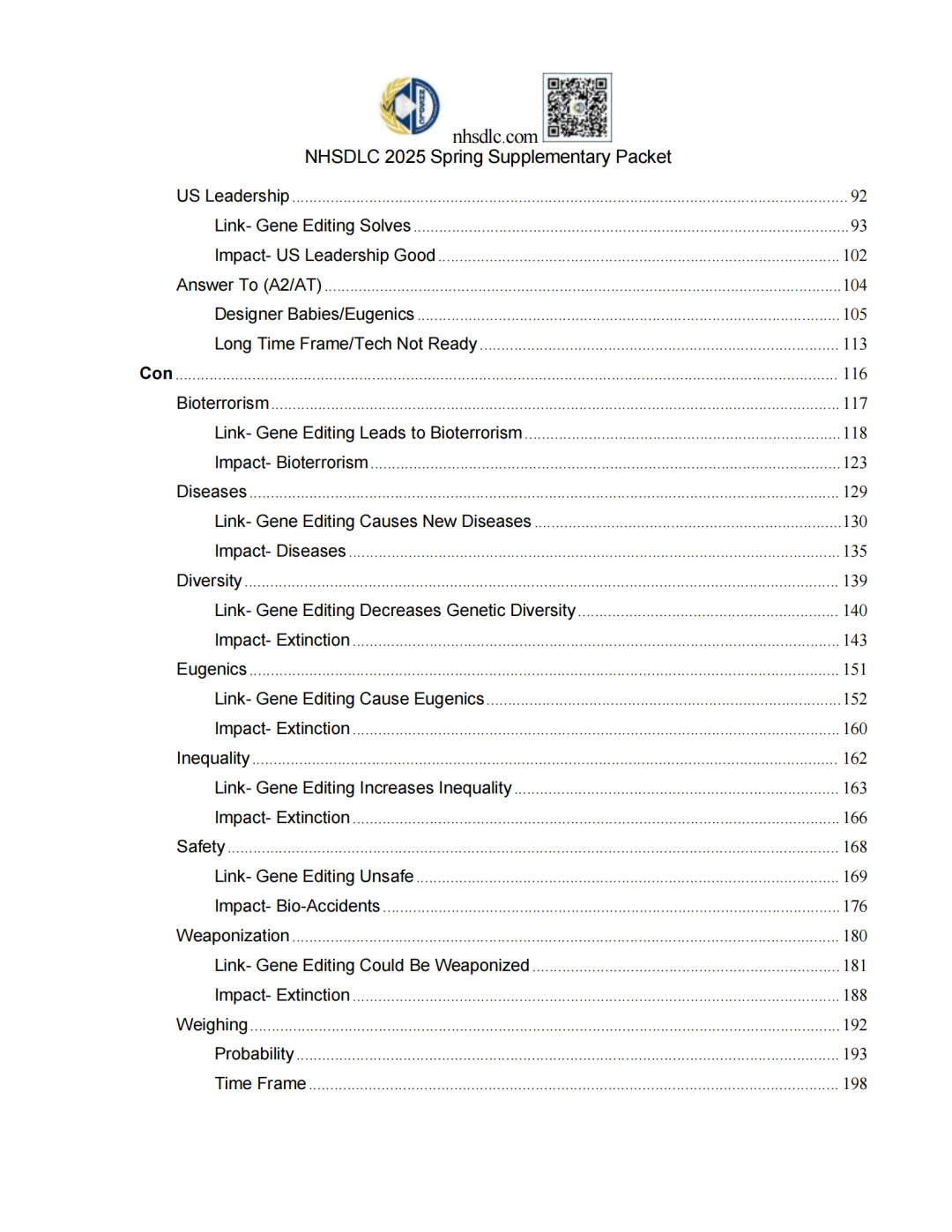春节即将过完大家可以根据春季常规赛时间安排表,紧锣密鼓开展复习计划啦!
上个月答应大家的NHSDLC 2025 春季Sample Case和补充资料包今日如约奉上!快来一起看看吧~
2025春季辩题

虽然治疗遗传疾病和改善人类健康的前景广阔,但广泛使用这些技术的伦理、社会和实际影响也提出了重大问题。辩题的核心矛盾在于要求辩论者权衡扩大使用范围所带来的变革性益处与潜在危害和意外后果。
当我们深入探讨这一话题时,也同时在试图解决我们这个时代最紧迫、最复杂的问题之一:人类是否已经准备好,是否有能力对自己的基因命运行使这种前所未有的权力。

Sample Case
PRO
Resolved: Expanding access to human gene editing technologies is more beneficial than harmful.
We affirm.
Our framework for the debate is cost-benefit analysis. If we prove that expanded access to human gene editing creates more advantages than disadvantages, then we win.
Contention 1: Diseases
A. Link- First, genome editing solves broadly by creating disease-preventing mutations. Independently, infertility causes extinction.
KatherineDrabiak21, JD, Professor at the University of South Florida College of Public Health and College of Medicine, Co-Director of the Law and Medicine Scholarly Concentration Program at USF’s Morsani College of Medicine, 1/1/2021, “Untangling the Promises of Human Genome Editing,” Journal of Law, Medicine, & Ethics, 46(4), p. 993,
Genome editinghas not only beenpresentedas a method to prevent monogenic disease, butas a means toeradicatediseasegenerally. Savulescu and colleagues called for using genome editing to prevent congenital birth defects, which they estimate affect 6% of the population totaling eight million children annually.42 Some call for usinggenomeeditingas a therapeutic solution tocorrectmultifactorialdiseasesuch as cancer, diabetes, and agerelated illness, and protectagainst theburdenof chronic disease.43These characterizationsequategenome editingaspreventivemedicinethat will rid society of the burden of diseasebecause scientistscouldinduce mutationsdesignedto conferprophylactichealthbenefits, functioningas apublichealth intervention.44 Characterizing genome editing as a protective mechanism or means of restoring genomic integrity invokes what legal scholar Ifeoma Ajunwa refers as a the “whisper of eugenics,” where individuals have a moral obligation to “scrub deleterious mutations from the germline” as part of a duty to prevent disease that threatens society.45 This covert eugenics message is far more dangerous, precisely because it aims to be an invisible hand defined by rational science guiding the public and policymakers to accept only one logical conclusion.
In addition to prevention of disease,somehaveproposed using genome to treatinfertilityand impairedfecundityby targeting mutations that somescientistsassert are linked toinfertility.46 Statistics vary, but according to the Centers for Disease Control, approximately twelve percent of couples in the U.S. suffer from impaired fecundity, defined as the inability to get pregnant or carry a baby to term.47 The World Health Organization evaluated global rates of infertility, finding up to one quarter of couples of childbearing age suffer from infertility.48 In the U.S., 62 million women of childbearing age are infertile and 7.4 million women seek fertility services during their life.49 Although a portion of infertility stems from aging, the fastest growing female population for those suffering from subfertility are those aged fifteen to twenty-four.50 Nor is infertility is confined to females: on the population level, male sperm count has dropped dramatically in the past few decades, along with a decrease in sperm motility and an increase in morphological abnormalities.51Declining reproductionin some areasfallsbelowreplacement level, whichpromptedthe World Health Organization to investigate causal factors, and media’s sensationalist headlinesproclaimingimpendinghuman extinction.52Declining and impaired fertility not only affects theindividualorcouple, but presents substantial public health ramifications becausereproductive health complicationssignal a connected burden of other diseases.53
Second, genetically engineered vaccines prevent all diseases.
IngridHaanEt al 16BaharRamezanpour Vrije Universiteit Amsterdam, Earth & Life Sciences, Athena Institute and Ingrid Haan Vrije Universiteit Amsterdam, Earth & Life Sciences, Athena Institute, De Boelelaan 1085, 1081 HV Amsterdam, The Netherlands Ab Osterhaus University of Veterinary Medicine Hannover, Foundation, Bünteweg 17, 30559 Hannover, Germany Eric Claassen Vrije Universiteit Amsterdam, Earth & Life Sciences, Athena Institute, De Boelelaan 1085, 1081 HV Amsterdam, The Netherlands December 7 2016 accessed 11/17/2022 from ScienceDirect "Vector-based genetically modified vaccines: Exploiting Jenner’s legacy "
Theglobal vaccine marketis diverse whilefacingaplethora of novel developments.(GM)techniquesfacilitate thedesignof’smarter’ vaccines. For manyof themajor infectious diseasesof humans,like AIDS and malaria, but also for most human neoplastic disorders, still no vaccines are available. It may be speculated thatnovelGM technologieswillsignificantly contribute totheirdevelopment. While a promising number of studies is conducted on GM vaccines and GM vaccine technologies, thecontribution of GM technology to newly introduced vaccines on the market is disappointinglylimited.In this study, the field of vector-based GM vaccines is explored. Data on currently available, actually applied, and newly developed vectors is retrieved from various sources, synthesised and analysed, in order to provide an overview on the use of vector-based technology in the field of GM vaccine development. While still there are only two vector-based vaccines on the human vaccine market, there is ample activity in the fields of patenting, preclinical research, and different stages of clinical research. Results of this study revealed thatvector-based vaccines compriseasignificant part ofallGM vaccines in the pipeline. This study further highlights thatandare among the most prominent vectors in GM vaccine development.After the approval of the first vectored human vaccine, based on a flavivirus vector,vaccinevectortechnology, especially based on poxviruses and adenoviruses,holds great promise for future vaccine development. It maylead to cheapermethods for the production ofsafe vaccines against diseases for which noor less perfectvaccines exist today,thus catering for an unmet medical need. After the introduction of Jenner’s asthefirst vaccinemore than two centuries ago,whicheventuallyled tothe recenteradication of, thisand other virusesmay now be the basis forconstructing vectors thatmay help uscontrol other major scourgesof mankind.
B. Impact- The next wave of diseases could cause extinction
Diamandis, 22–Head of Clinical Biochemistry in the Department of Laboratory Medicine and Pathobiology at the University of Toronto in Toronto
[Eleftherios P Diamandis, "The mother of all battles: Viruses vs humans. Can humans avoid extinction in 50–100 years?," PubMed Central (PMC), 01-29-2022, https://www.ncbi.nlm.nih.gov/pmc/articles/PMC8802343/]
The recent SARS-CoV-2 pandemic, which is causingCOVID-19 disease, hastaught us unexpected lessons aboutthe dangers of human suffering through highly contagious andlethal diseases.As the COVID-19 pandemic is now being partially controlled by various isolation measures, therapeutics, and vaccines, it became clear thatour current lifestyle and societal functions may not be sustainablein the long term. We now have to start thinking and planning on how to face the next dangerous pandemic, not just overcoming the one that is upon us now.Is there any evidence thateven worse pandemics could strikeusin the near futureand threaten the existence of the human race? The answer is unequivocally yes.It is not necessary to get infected by viruses found in bats, pangolins, and other exotic animals that live in remote forests to be in danger. Creditable scientific evidence indicates thatthe human gutmicrobiotaharbor billions of virusesthat arecapable of affectingthe function ofvitalhumanorganssuch as the immune system, lung, brain, liver, kidney, or heart. It is remotely possible thatthedevelopment of pathogenic variantsin the gutcan lead to contagious viruses, whichcan cause pandemics, leading to thedestruction of vital organs, causing deathor variousdebilitating diseasessuch asblindness, respiratory, liver, heart, and kidney failures.Thesediseases couldresult in the completeshutdown of our civilizationandprobably the gradualextinctionof the human race. This essay will comment on a few independent pieces of scientific facts, and then combine this information to come up with some (but certainly not all) hypothetical scenarios that could cause human race misery, even extinction, in the hope that these hypothetical scenarios will trigger preventative measures that could reverse or delay the projected adverse outcomes.
Contention 2- Space Colonization
A. Link- Gene editing key to radiation shielding and drug synthesis for space colonization---extinction.
DavidWarmflash 17, U.S. Principal Investigator: Phobos Living Interplanetary Flight Experiment, Post-Doctoral Fellow in the Department of Radiation Oncology, University of Pennsylvania, Former NRC Post-Doctoral Fellow at the NASA Johnson Control Center, Former Research Associate in Astrobiology at the University of Houston, “Quest To Colonize Space Demands Boost From Biotechnology, Synthetic Biology”, Genetic Literacy Project, 9-8, https://geneticliteracyproject.org/2017/09/08/quest-colonize-space-demands-boost-biotechnology-synthetic-biology/
As vital assynthetic biologywill be to the early piloted missions to Mars and voyages of exploration, itwill becomeindispensableto establish along-termhumanpresence off-Earth, namelycolonization.That's because we've evolved over billions of years to thrive specifically in the environments provides by our home planet.
Ourphysiologyiswell-suited to Earth'sgravityand its oxygen-richatmosphere.Wealsodepend on Earth's globalmagnetic fieldto shield us fromintense spaceradiationin the form of charged particles.In comparison,Marshas onlypatchesof localized magnetism, thought to be remnants of a global magnetic field in the distant past. Currently,the Red Planethasnoglobalmagnetic fieldthat could trapparticle radiationfrom interplanetary space. Also, the Martianatmosphere is so thin that anyshieldingagainstspaceradiationof any kindisminorcompared with the protection that Earth's atmosphere affords. At the Martian surface, atmospheric pressure never gets above 7 millibars. That's like Earth at an altitude of about 27,000 m (89,000 ft), which is almost the edge of space. And while the moon's proximity to Earth could make it a better location than Mars for the first off-world colony, the lunar radiation environment is similar to that of Mars. That's because the moon has practically no atmosphere at all, plus it too lacks a global magnetic field. On the moon, or on Mars, early colonists must live underground.
Living off the land: Creating Earth-like environments away from Earth
Livinganywherein our Solar Systembeyond Earthwill requirethesamelevel ofprotectionthat an astronaut needs while walking in space.Ahuman-friendlyenvironment must be providedtosustain life, and forlong-term human presencethat environment must besustainable.In contrast to short flights into low-Earth orbit, or brief visits to the Moon,space colonistswill not be able to rely ondeliveriesof air, water, and food from Earth; instead theywill have tolive off the land.They'll have to create Earth-like environments with consumables derived from local materials and recycled the way that air, water, and things that we eat are replenished on our home world.
Thelack of technologyfor such sustainable life support systemsisa majorfactorunderlyingcriticism of humanspaceexploration. And it's not the only factor. There's also the high cost of human space flight and the substantial risk to human life. Weighed against the staggering advances in computers, robots, and nanotechnology,the argument for sending astronautsto explore space instead of robot probes seems weak, except when one more issueisadded to the equation:extinction insuranceagainstplanet-wide disasterscausedeither bynature, orby ourownnegligence.
Louis Friedman, a space policy expert and astronautical engineer, embraces both the pro-human and pro-robot perspective in his book. He does this by arguing thatoff-worldcolonizationwill beneeded, and therefore accomplished soon,to assurelong-term survivalof humanity, with Mars as the chosen location for our second home. But when it comes to exploration deeper into space, Friedman believes we'll opt to leave that task to our robot emissaries. The reason, which he outlined in an interview with this writer for Discover Magazine, is that technology — including biotechnology that will enable uploading of the visual, audio, and other sensory experiences of our robot explorers to the human brain — will make virtual travel to distant locations better than the real thing, so why put the fragile human body at so much risk?
How much risk is acceptable may be a matter of opinion, but in addition to making a virtual space exploration experience, biotechnology also could reduce the risk to humans who do choose to travel through space physically. In a paper published in the Journal of the Royal Society, University of California, Berkeley aerospace engineer and synthetic biology researcher Amor Menezes suggested six key challenges to establishing a human space presence that could be addressed with synthetic biology.
Synthetic biology and the challenges of space colonization
The first challenge, Menezes and his colleagues explain, is resource utilization. Unlike the Pilgrims on the shores of America, early colonists on the Moon or Mars will not be able to get their dinner by going fishing, but they could make the lunar or Martian dirt into soil for growing plants. The Moon has water in the form of ice that they could melt and both water and the lunar rocks contain oxygen that can be drawn out through electrochemical reactions. Rather than discard the carbon dioxide that humans exhale as is done on spacecraft, colonists could use the waste gas as a carbon source for making food. We already have organisms that do this. They include plants and photosynthetic bacteria, butgenetic engineeringhas beenmakingthecarbon fixationprocess tocreate food moreefficient, andfuturemodificationcould be tailoredtomakeoptimize photosynthesisfor the dirt and environments ofthe Moon and Mars.In addition to food production, organisms can also be engineered to convert Martian and lunar materials into fuel that could be used for rockets, and finally the organisms could be used to process waste.
In addition to using locally derived resources, spacecolonistswillneedto engage inmassive manufacturing. Menezes believes that organisms could be engineered to produce biocement, biopolymers, adhesives, and other building materials. By recycling air and water. processing solid wastes, and producing food,geneticallymodifiedorganismscould also play acentralrole inlife supportsystems, which the paper lists as the third challenge for a long-term human space presence.
As for the fourth challenge, the researchers discuss space medicine and human health applications. Examples of howgenetic engineeringcanhelpinthis area includeonsite synthesisof drugs, a capability that will bevitalto colonizations, since drugs are vulnerable to radiation, making the prospect of transporting medicines from Earth unattractive. At the same time,modified organisms mightalsobe developed tocreateradiation-resistantclothing andotherbioshielding material.
Space cybernetics is the fifth challenge. For reasons similar to the drug manufacture issue, space colonists will be better off making their own electronics rather than depending on electronics shipped from Earth, and biosynthetic approaches could be the right tactic.
Terraforming
The final challenge, one that Menezes and the team admits is the most difficult, is called terraforming. Whether on the Moon, Mars, or even an asteroid, living inside a pressurized module won't be satisfying for more than a short bout. For long-term residence,humanswillneedenvironmentsthat look and feelnatural, with plenty of trees, parkland, and rivers and streamsin order tothrive.
The process of converting an entire planet like Mars or Venus into a world with a breathable atmosphere and a comfortable temperature is called terraforming. Scientists think that it could be technically possible, but terraforming an entire Mars-like world would probably take centuries and possibly even millennia. For this reason, space colonization proponents are also considering a less ambitious goal known asparaterraforming, basically terraforming but on a limited area of another world. On the Moon, for instance, a large crater, such as the 21 kilometer wide Shackelton crater on the Moon's south pole, could be sealed with a dome and the inner environmentcould beterraformed injustafew years. On Mars, caves could be sealed and terraformed, while a small asteroid could be hollowed out, terraformed on the inside and even spun to create Earth-equivalent gravity. In all of these cases,engineered organismswould bekeyto the paraformation process. As on Earth, success would be more likely for those willing to start small, and the creation of an Earth-like environment on a small scale would demonstrate that, in the future,it might also beachieved on aplanetary scale.
If a long-term human presence onother worldsis the goal, then genetically altered organisms are the key.If this is the case, andif wedo decide thatextinction insurancemakes sense, it would mean thathumansurvivalitselfdepends on thecontinued development of biotechnology.
B. Impact- Each delay in space colonization outweighs
Nick Bostrum 03Oxford University http://www.nickbostrom.com/astronomical/waste.html Astronomical Waste: The Opportunity Cost of Delayed Technological Development, Utilitas Vol. 15, No. 3 (2003): pp. 308-314
As I write these words, suns are illuminating and heating empty rooms, unused energy is being flushed down black holes, and our great common endowment of negentropy is being irreversibly degraded into entropy on a cosmic scale. These are resources that an advanced civilization could have used to create value-structures, such as sentient beings living worthwhile lives.
The rate of this loss boggles the mind. One recent paper speculates, using loose theoretical considerations based on the rate of increase of entropy, that the loss of potential human lives in our own galactic supercluster is at least ~10^46 per century of delayed colonization.[1] This estimate assumes that all the lost entropy could have been used for productive purposes, although no currently known technological mechanisms are even remotely capable of doing that. Since the estimate is meant to be a lower bound, this radically unconservative assumption is undesirable.
We can, however, get a lower bound more straightforwardly by simply counting the number or stars in our galactic supercluster and multiplying this number with the amount of computing power that the resources of each star could be used to generate using technologies for whose feasibility a strong case has already been made. We can then divide this total with the estimated amount of computing power needed to simulate one human life.
As a rough approximation, let us say the Virgo Supercluster contains 10^13 stars. One estimate of the computing power extractable from a star and with an associated planet-sized computational structure, using advanced molecular nanotechnology[2], is 10^42 operations per second.[3] A typical estimate of the human brain’s processing power is roughly 10^17 operations per second or less.[4] Not much more seems to be needed to simulate the relevant parts of the environment in sufficient detail to enable the simulated minds to have experiences indistinguishable from typical current human experiences.[5] Given these estimates, it follows that the potential for approximately 10^38 human lives is lost every century that colonization of our local supercluster is delayed; or equivalently, about 10^29 potential human lives per second.
While this estimate is conservative in that it assumes only computational mechanisms whose implementation has been at least outlined in the literature, it is useful to have an even more conservative estimate that does not assume a non-biological instantiation of the potential persons. Suppose that about 10^10 biological humans could be sustained around an average star. Then the Virgo Supercluster could contain 10^23 biological humans. This corresponds to a loss of potential equal to about 10^14 potential human lives per second of delayed colonization.
What matters for present purposes is not the exact numbers but the fact that they are huge. Even with the most conservative estimate, assuming a biological implementation of all persons, the potential for one hundred trillion potential human beings is lost for every second of postponement of colonization of our supercluster.[6]
Contention 3- Extinction Proof
A. Link- First, gene editing makes humans extinction-proof.
The Economist 19, interviewing Jamie Metzl, author of Hacking Darwin, Senior Fellow at the Atlantic Council, former member of the U.S. National Security Council, 4/25/19, "How genetic engineering will reshape humanity,”
https://www.economist.com/open-future/2019/04/25/how-genetic-engineering-will-reshape-humanity
NEW GENETIC technologies areexhilaratingand terrifying.Society mightovercomediseases by tweakingindividualgenomesor selectingspecific embryosto avoidhealth problems. But it may also give rise to "superhumans" who are optimised for certain characteristics (like intelligence or looks) and exacerbate inequalities in society.
What is certain is that people will be able to make decisions about their lives in ways that were impossible in the past, when we relied more on random evolution than deliberation. In the words of Jamie Metzl, we are "Hacking Darwin," the title of his latest book. It is a thoughtful romp through new genetic technologies, with insights on what it means for individuals, society and even great-power politics.
The theme draws together discrete strands of Mr Metz's diverse background. He's worked for the United Nations on humanitarian issues in Cambodia and served on America's National Security Council under President Bill Clinton. He's been an executive at a biotechnology company, a partner at large investment fund in New York and a candidate for Congress from Missouri. But perhaps even more relevantly, he is the author of two sci-fi novels on genetics, "Genesis Code" and "Eternal Sonata."
As part ofThe Economist’sOpen Future project, we asked Mr Metzl about genetic engineering, inequality and the new “liberal agenda”. Below the interview is an excerpt from his book, on the history of eugenics.
The Economist: What are the ways in which people are able to "hack Darwin" today and over the next 15 years or so?
Jamie Metzl:We have always fought against the inherent cruelty of natural selection, one of the two essential pillars of Darwinian evolution.We are now beginning to hack away atthe second pillar,random mutation. Ourgrowing understanding ofhowgenesand biologyfunctionis opening the door toincredible medical applicationslike using genome sequencingand gene therapiestofightcancerand otherdiseases. But thehealthcareapplicationsof genetic technologiesare only astation along the wayto wherethesetechnologiesare taking us.
Our ability to select embryos during in vitro fertilisation (IVF)—based on informed genetic predictions of both health-related traits and intimate characteristics like height, IQ and personality style—will grow over the coming years. We’ll use stem cell technologies to expand the number of eggs that prospective mothers can use in IVF and therefore the range of reproductive options for parents. We’ll deploy gene editing tools far more precise than today’s CRISPR systems to make heritable genetic changes to our future offspring. Over the coming decades, Darwin’s original concept of random mutation and natural selection will gradually give way to a process that is far more self-guided than anything Darwin could have imagined.
The Economist:Changingthenature ofwhat it means to behuman hashuge consequences. What are the main ones?
Mr Metzl:We have internalised the idea that information technology is variable, which is why we expect each generation of our phones and computers to be better than the last. It’s harder for us to come to grips with the idea that our biology could be as variable as our IT, even though we understand intellectually that somehow we evolved from single cell organisms to complex humans over the past 3.8 billion years.Starting to see all of life, including our own,asincreasinglymanipulablewill force us to thinkmoredeeply about whatvalueswill guide us as we begin altering biology moreaggressively.
If we wantto avoid dividing our species into genetic have and have-nots—a dangerous reduction in our diversity—or a genetic determinism that undermines our humanity, we’llneed to start living our values. But though we need to be mindful of the dangers, we must also keep in mind thatthese technologies havethepotential to dotremendous good. Somedaytheymightwellhelp us avoidextinctionleveleventslikedangeroussynthetic pathogens, awarmer climate, thefallout fromanuclear warortheeventualexpiration of our sun.
Second, it makes climate change, diseases, and nuclear war survivable. Human rights frame drives productive use.
Metzl 19,[Jamie Metzl is a leading technology and healthcare futurist, geopolitical expert, novelist, entrepreneur, and media commentator, Founder and Chair of the global social movement OneShared.World, and an Atlantic Council Senior Fellow and Singularity University faculty member, “How genetic engineering will reshape humanity,” April 25, 2019,
https://www.economist.com/open-future/2019/04/25/how-genetic-engineering-will-reshape-humanity]
The Economist: What are the ways in which people are able to "hack Darwin" today and over the next 15 years or so?
Jamie Metzl: We have always fought against the inherent cruelty of natural selection, one of the two essential pillars of Darwinian evolution. We are now beginning to hack away at the second pillar, random mutation.Our growing understanding of how genes and biology function is opening the door to incredible medical applications like using genome sequencing and gene therapies to fight cancer and other diseases. But the healthcare applications of genetic technologies are only a station along the way to where these technologies are taking us.
Our ability to select embryos during in vitro fertilisation (IVF)—based on informed genetic predictions of both health-related traits and intimate characteristics like height, IQ and personality style—will grow over the coming years. We’ll use stem cell technologies to expand the number of eggs that prospective mothers can use in IVF and therefore the range of reproductive options for parents.We’ll deploygene editingtoolsfar more precise than today’s CRISPR systems to makeheritable genetic changesto our future offspring.Over the coming decades, Darwin’s original concept of random mutation and natural selection will gradually give way to a process that is far more self-guided than anything Darwin could have imagined.
The Economist: Changing the nature of what it means to be human has huge consequences. What are the main ones?
Mr Metzl:We have internalised the ideathat informationtechnologyis variable, which is why we expect each generation of our phones and computers to be better than the last. It’s harder for us to come to grips with the idea that our biology could be as variable as our IT, even though we understand intellectually that somehow we evolved from single cell organisms to complex humans over the past 3.8 billion years.Starting to seeall oflife, including our own,asincreasinglymanipulablewill force us to thinkmore deeplyabout whatvalueswillguide usas we begin altering biology more aggressively.
If we want toavoid dividing our speciesinto genetic have and have-nots—adangerous reductioninourdiversity—oragenetic determinismthatunderminesourhumanity,we’ll need tostart living our values. But though we need to be mindful of the dangers, we must also keep in mind thatthese technologieshave the potential to do tremendous good. Someday they might wellhelp usavoid extinctionlevel events likedangerous synthetic pathogens,a warmer climate, thefallout from anuclear waror the eventual expiration of our sun.
The Economist: Do we have the ethical framework to handle this? If not, what might it look like if things go wrong?
Mr Metzl:We create beautiful art, philosophy and universal concepts likehuman rightsbut wipe out millions of each other in wars and genocides and still today invest massive amounts of our collective wealth in tools of mass murder.The “better angels of our nature”remainprimarydriversinourdevelopment ofgenetic technologies, but the dark side of human nature could also be empowered through these same tools.We need averystrongethicaland culturalframeworkto increasetheoddsthatwe’ll usethesetechnologies wisely,not least because access to them will be decentralised and democratised.
Although the positive possibilities far outweigh the negatives, it would be crazy to ignore the many ways things could go wrong.Like Icarus, we could fly too close to the sun and get burned if we hubristically assume we know more than we actually do.Ourgene drivescouldcrash ecosystems. We could use these tools to undermine our common identity as a species and social cohesion. The good news is that while thetechnologiesare new, thevalueswe’ll need to use them wiselyare often old.
B. Impact- Prioritize existential risk. It’s mathematically and ethically correct.
Sánchez ’17(David; 2/8/17; BA in Public Policy, BA in Economics and Philosophy, expert at the Kenan Institute for Ethics, citing Nick Bostrom, PhD in Philosophy; Duke’s The Chronicle; “Existential risks”)
How often do you think about the end of the world? Some people think about it quite a bit. Within Effective Altruism circles, many people share a concern for the future of humanity. Effective Altruists attempt to combine good intentions with science and reasoning to find the best ways to do good, whether for humans or non-human animals.Mitigation ofso-called“existential risks” is ahugepriorityfor some of their more risk-seeking members.An existential risk, put simply,is someclass ofpossible event that presents arisk of extinctionto humanity. Nick Bostrom, Oxford philosopher and existential risk extraordinaire, defines it this way: “One where an adverse outcome would either annihilate Earth-originating intelligent life or permanently and drastically curtail its potential.” Somemain classes of existential risk includecatastrophicclimate change, malicious artificial superintelligence, the emergence of malicious nanotechnology,nuclear warand maliciousbio-tech, among others.When considering the threats posed byso-called“x-risks,”there areat leastthree factors to keep in mind.First, bear in mind thatif humanity continues for theforeseeablefuture, thenthe number ofpotentialpeople in the future will besignificantly higherthan the number who exist todayor have existed in the past. Additionally,the expected disutility of extinction-levelevents is massive, meaning thateven a small mitigationof those probabilities results in ahuge positive. Per one interpretation of the evidence, “even if we use themost conservativeof theseestimates… we find thatthe expected loss ofan existentialcatastrophe is greater thanthe value of1016human lives. This implies thattheexpectedvalue of reducingexistentialrisk bya mereone millionth of one percentage pointisat leastahundred times the value of a million human lives.” If this holds even remotely true, then surely we should keep listening.Second, consider that someexperts believe the probability of extinction-levelevents issomewhathigh. In a report released byOxford’sFuture of Humanity Institute, a survey ofexperts found the likelihood of extinction by the year 2100 to bea whopping19 percent. While this number should be taken with a grain of salt, it is unsettling thatpeople in the know aresopessimistic about our odds.Third, bear in mind thatthere are very, veryfew people dedicated to mitigatingtheseexistential risks. Somelimited efforts exist, but they are low-staffed and underfunded. As Nick Bostrom has noted,even “a million dollars couldcurrentlymake avast differencetothe amount of research done onexistential risks; the same amount spent onfurtheringworld peace would belikea drop in the ocean.” If you’re looking for a cause with a funding gap, this might be just the ticket. Lookingthroughout history,we can findplenty of examples of near-nuclear war; the Future of Life Institute compiled a nice list of the most notable. What this might show us is thatour planet hasalmostfaced near-extinctionlevelevents in the past. One reasonwe are all still hereisbecause peopleworked tocraft systems thatwouldavoid careless mistakesor oversights. In other words,we built systems thatattempted tomitigate these risks.Ifthese systems had not been in place, andlazy fail-safes failed to prevent disaster, thenwhat would have happened?Perhaps not outright extinction, butdisaster indeed. During the Cold War, the notion of “mutually assured destruction” was not some abstract; it was a working possibility, one that humanity had to take seriously. Sotoday, in a world withever-advancing technology andgeopolitical uncertainty, we lack a compelling reason not to take thesesorts ofrisks seriously. The need to mitigate existential risk stands or falls with free will—if it does not exist, then there is little or no case to be made. But if it does—even to an extent—thenwe have every reason toat leastlisten totheexperts. So, perhaps my thesis is that insofar as a person believes humans have free will (i.e. a degree of autonomy over their destinies), he or she likely will have reason to support causes that mitigate the risks imposed by disaster scenarios. This is not meant to take a stand on cause prioritization. It might be more worthwhile still to donate to groups that fight global health problems or empower people economically. However, excluding opportunity cost, donatingtimeor moneyto mitigating these threats islikelynet positive, depending on the efficacy of the organization or project.Given that we have not observed an existential threat play out in the past,wemight be biasedtowards believingthatone might never emerge. Accordingly,this is an area where rational thinking isabsolutelyessential. In my view, whether or not to support or donate to these causes is an open question. But ifthe whole of humanity isat stake, it is at least a conversation worth having.
Sample Case
CON
Contention 1: Deadly Diseases
Expanding access to human gene editing technologies poses a huge risk by increasing the likelihood of engineered diseases, which could surpass natural pandemics in severity and even threaten human survival.
According to Cotton-Barrett et al. 17, natural pandemics, while deadly, have historically been unlikely to cause human extinction due to the evolutionary balance between pathogens and their hosts. Recent advances in biotechnology, however, permit the artificial construction of a pathogen that can break free from such constraints. Already, researchers have demonstrated that it is possible to create vaccine resistant smallpox and human-to-human transmissible avian flu, the latter two of which could spread globally and kill millions of people. And as gene editing technology becomes more accessible, country’s and even terrorist organizations might create pathogens with the potential to wipe out large groups of people (Cotton-Barrett et al. 17).
CRISPR technology has opened the floodgates for bioengineered viruses, potentially allowing for unintended and disastrous consequences. As Mack 2016 explains, germline editing where changes to DNA are inherited by future generations, creates irreversible alterations with unknown risks. The potential for unintended genetic "bugs" or even deliberate genetic manipulations poses a serious security risk to humanity. Once this technology becomes widespread, it will be nearly impossible to regulate it effectively, leaving open the possibility of underground or black-market applications Mack 16States.
Gene editing has already shown the potential to create a biological agent deadlier than naturally occurring diseases. Kosal 2020 refers to the Australian Mouse Pox Experiment, in which researchers accidentally created a virus that would kill even vaccinated mice.The experiment was repeated later with the same results, proving that gene editing could produce pathogens resistant to all existing countermeasures. If such methods were used against human pathogens, we would face a pandemic that outpaces our ability to stop them (Kosal 20)
Impact: Human Extinction
As gene editing technology becomes more available, if adequate security measures are not in place, we could be facing an oncoming storm of super-diseases. As Diamandis 22 notes, modern society cannot handle anything other than COVID-19, and the next pandemic could be even worse.Engineered viruses would manipulate human biology in ways that no naturally occurring pathogen could ever dream of and cause the most unimaginable catastrophes, such as massive deaths and complete societal breakdowns, among others, arguedDiamandis 22. Warwick 2016 says that contagious diseases are one of the most immediate existential threats to civilization. Given that pandemics of the past, like the Spanish flu, killed up to 100 million people, the possibility of bioengineered viruses causing even greater destruction is not just theoretical it is a pressing danger (Warwick 16).
Contention 2: Weaponization
According to Metzl 2019,Gene editing is not going to be utilized for medical progress alone but also for military and geopolitical use. Gene editing can provide an avenue for artificially engineering "superhumans" enhanced for intelligence or physical traits, leading to a dangerous biological enhancement arms race. Worse, the rapid democratization of gene editing tools makes it increasingly infeasible to prevent their misuse by nefarious actors. The same gene editing technologies that facilitate research into human enhancement could also be leveraged by governments and non-state actors interested in developing bioweapons targeting particular populations or individuals with exponentially enhanced capacities for mass destruction (Metzl 19).
More especially, whole-genome sequencing has opened floodgates for a new class of bioweapons manufactured using genetically engineered techniques. As Foley 2013 mentions, the development of DNA synthesis now enables the creation of new pathogens, such as viruses that are more infective, virulent, and resistant to drugs. This kind of manipulation would enable attackers to design diseases around existing treatments and vaccines. Other techniques, including binary biological weapons, stealth viruses, and personalized bioweapons-pathogens that target specific genetic profiles-are no longer concepts of science fiction but very realistic ones. Increasing access in a world with better genetic engineering techniques and computational powers will make bioweapon development easy and cheap, the risks have never been greater in today’s world argues Foley 13.
Impact: Human Extinction
The wrong application of the editing of genes holds the potential for human extinction. Pandya 19 warns that though gene editing is of great medical benefit, it is also a dual-use technology, like a sword that can be turned into a weapon of mass destruction. The emergence of DIY gene editing and "democratization of destruction" presumes the impossibility of monitoring who is making what genetic modification, where, and for what purpose. Gene editing could be used to develop targeted diseases, that are capable of wiping out complete populations if the technology falls into the wrong hands (Pandya 19).
Regalado 2016 further mentions that U.S intelligence officials have listed the genome editing as WMDs. Also, considering the low cost of CRISPR, countries having a lower regard to ethical matters can easily manipulate biological agents to harm or create genetically engineered plagues. The U.S. intelligence community says biotechnology is "dual-use," meaning it can be harnessed for good and evil. With its ease of use and fast development, gene editing poses a huge national security risk, and an accident or deliberate attack with engineered pathogens could be catastrophic(Regalado 16).
Contention 3: Inequality
With increasing access to human gene editing technologies, existing social and economic disparities will widen, and the genetically privileged and the genetically disadvantaged will be permanently divided.
Sherman 17 claims that gene editing does indeed hold the promise of eliminating genetic diseases but ultimately will be added to a long list of tools used by the wealthy in securing advantages for their children.In the same way that privileged families today are already investing in private education, and elite tutoring, gene editing is just another thing added to that list that the privileged can afford. Genetic edits for intelligence, physical attractiveness, and even height. Things in themselves that are already strongly correlated with professional and financial success. This will serve only to increase the disparity between rich and poor. Over time, a genetically enhanced elite will emerge, further entrenching existing social hierarchies and making upward mobility nearly impossible for those who cannot afford genetic enhancement (Sherman 17).
Gene editing will be driven by market forces, leading to consumer eugenics and the rise of designer babies. Dr. King 2017 warns that the free market will not stop at curing diseases but will push toward genetic enhancements that cater to the wealthy.The U.S. egg donor market already reflects this dynamic, with Ivy League graduates being paid exponentially more for their eggs than working-class women. This will extend to gene editing, where well off parents will be able to create children with superior genetic traits, ensuring that future generations of the wealthy are biologically superior to the rest of society. Once genetic inequality is encoded into DNA, the very idea of human equality will be erased, as wealth will no longer just buy opportunities it will buy superior biology (King 17).
Impact: Inequality and extinction
The long-term effects of this genetic inequality may therefor be disastrous, a future of genetically improved elites. As Dr. Jones 09 says unless that trend is checked, in a not too distance future, genetic engineering will be used to create a different class of man by the rich.Over generations, the elite would change so considerably that they would be as different from today's human beings. The "naturals" would be regarded as backward and inferior beings, competitors for the necessities of life but not as equals. If we allow gene editing, this could spell extinction for unmodified humans at the hands of the genetically superior. What was intended to enhance human life may ultimately result in mass extermination and the extinction of humanity as we know it (Jones 09).
完整资料包下载

提取码:utx4














